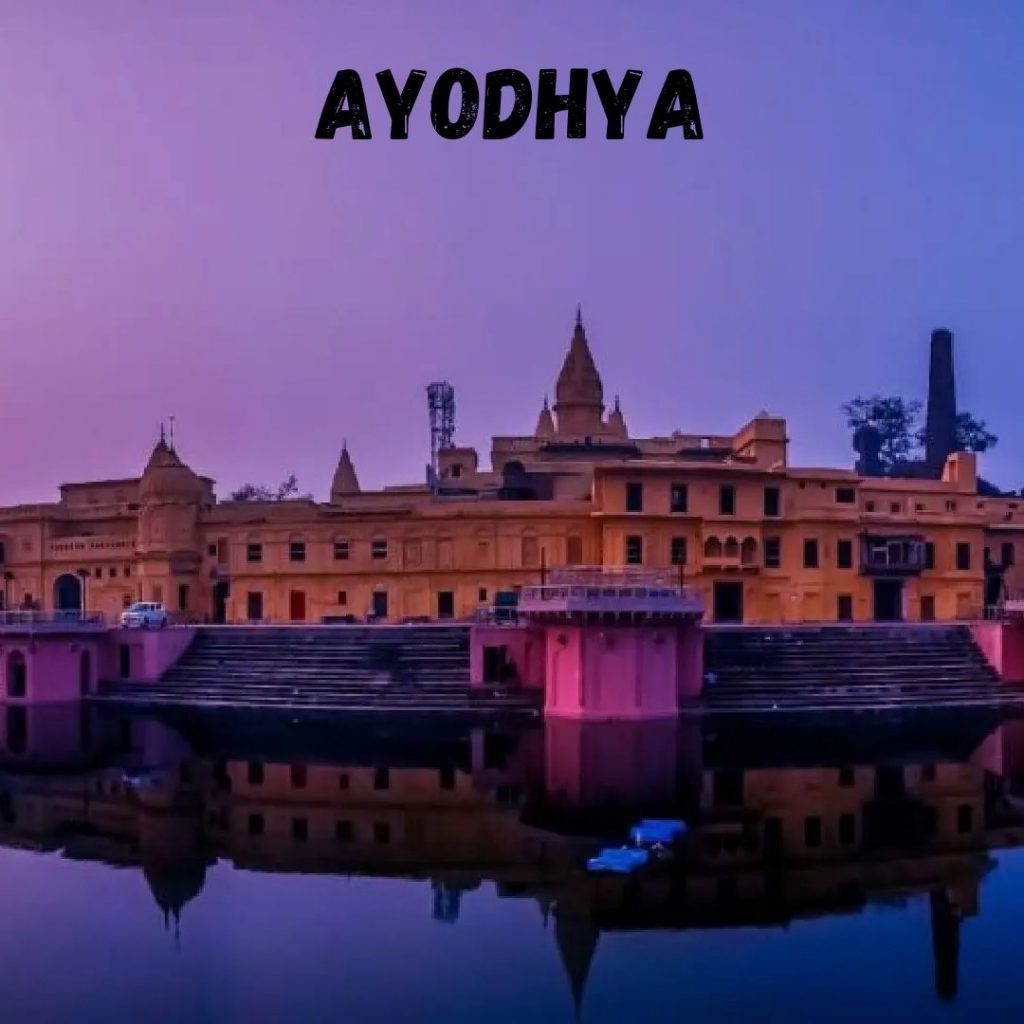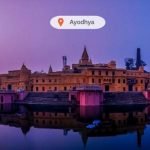Ayodhya, Ghats of Ayodhya ,the holy city on the banks of the Saryu River, is famous not only for its temples but also for its beautiful and historic ghats. These riverfront steps have witnessed centuries of devotion, spiritual rituals, and cultural heritage. Whether you’re a pilgrim seeking divine blessings, a photographer capturing scenic views, or a traveler exploring history, the ghats of Ayodhya offer a mesmerizing visual experience.
Join us on a photographic journey through the most iconic ghats of Ayodhya, where history, devotion, and nature come together to create unforgettable moments.

1. Ram Ki Paidi – The Most Iconic Ghat of Ayodhya
One of the most picturesque and significant ghats in Ayodhya, Ram Ki Paidi is known for its grand architecture, religious significance, Ghats of Ayodhya and breathtaking evening aarti. Devotees believe that bathing here cleanses the soul and brings peace.
Photography Highlights:
Sunset reflections on the Saryu River.
Evening Aarti with hundreds of floating diyas.
Temple silhouettes against the sky.
Best Time to Visit: Sunrise for a peaceful view, sunset for the Aarti experience.
2. Guptar Ghat – Where Lord Rama Took Jal Samadhi
According to legends, Guptar Ghat is where Lord Rama entered the Saryu River and left his mortal form. This Ghats of Ayodhya is peaceful, less crowded, and perfect for spiritual reflection and photography.
Photography Highlights:
Historic temples near the ghat (Chakrahari Shrine & Raja Mandir).
Monks meditating by the water.
Calm river waves in the early morning light.
Best Time to Visit: Early morning for misty, golden-hour shots.
3. Naya Ghat – The Best Ghat for Boating & Reflection Shots
Naya Ghat is one of the most active ghats, offering boat rides, stunning river views, and a lively atmosphere. The reflections of the colorful boats and historic structures in the river make it a perfect place for photography.
Photography Highlights:
Colorful boats on the Saryu River.
Sunset boat rides with temple views.
Pilgrims performing rituals along the steps.
Best Time to Visit: Late afternoon for golden light reflections.
4. Lakshman Ghat – A Spiritual & Historic Landmark
Named after Lakshman, the younger brother of Lord Rama, this ghat is believed to be the place where Lakshman meditated. It is a peaceful, sacred site where you can capture both historic architecture and religious activities.
Photography Highlights:
Old temples and meditation spots.
Sadhus and pilgrims engaged in prayers.
Monochrome shots of ancient stone steps.
Best Time to Visit: Early morning for a calm atmosphere and golden light.
5. Raj Ghat – A Ghat for Heritage & Architecture Lovers
One of the oldest ghats in Ayodhya, Raj Ghat is known for its historic charm, grand staircases, and temple spires that create stunning photography opportunities. It is less crowded, making it ideal for capturing the essence of Ayodhya’s spiritual past.
Photography Highlights:
Reflections of temples in the river.
Grand staircases leading to the water.
Contrast between old and new architecture.
Best Time to Visit: Morning light for golden hues and detailed textures.
6. Janki Ghat – The Ghat Dedicated to Goddess Sita
Janki Ghat is dedicated to Goddess Sita and is one of the most vibrant and colorful ghats in Ayodhya. It is an active site for religious ceremonies, making it an excellent location for candid and cultural photography.
Photography Highlights:
Women performing pujas in bright sarees.
Vibrant flower offerings floating in the river.
Close-up shots of temple carvings and rituals.
Best Time to Visit: Festival days like Ram Navami and Diwali.
7. Ram Ghat – A Perfect Blend of Culture & Nature
Located near Hanuman Garhi, Ram Ghat is a hidden gem that offers a peaceful setting for photography lovers. With its lush greenery, ancient steps, and calm waters, it is a great place to capture serene, nature-inspired images.
Photography Highlights:
Trees and greenery surrounding the ghat.
Monks and sages meditating by the river.
Reflections of the sky and ghats in the water.
Best Time to Visit: Morning for misty, soft-light shots.
8. Ram Ki Gaddi Ghat – The Place of Devotion
This lesser-known ghat is famous for its devotional activities, daily prayers, and cultural traditions. It offers an authentic experience of Ayodhya’s spiritual rhythm, perfect for documentary-style photography.
Photography Highlights:
Priests conducting morning aartis.
Vivid shots of offerings, diyas, and sacred threads.
Aged stone steps telling stories of devotion.
Best Time to Visit: Morning prayers or festival evenings.
9. Saryu Ghat – The Grand Riverside Experience
Saryu Ghat is an expansive ghat that provides the best panoramic views of the river. This is where many religious and cultural events take place, making it an exciting spot for action photography.
Photography Highlights:
Crowds gathering for special religious events.
Vibrant boats, temples, and prayer flags.
Golden reflections of evening lights on the water.
Best Time to Visit: Evening during Deepotsav or special puja celebrations.
Why Explore the Ghats of Ayodhya?
Capture the blend of devotion, culture, and nature.
Photograph ancient architecture and modern rituals together.
Experience the breathtaking evening Aarti at Ram Ki Paidi.
Enjoy boat rides for unique water reflections and cityscapes.
Ayodhya’s ghats are not just places of worship—they are living canvases of history, spirituality, and artistic beauty!
Final Thoughts
From the grand evening Aarti at Ram Ki Paidi to the historic silence of Guptar Ghat, every ghat in Ayodhya has a story to tell and a view to capture. Whether you are a pilgrim, traveler, or photographer, exploring these ghats will leave you with unforgettable moments and stunning images.
Planning a spiritual and photographic tour of Ayodhya? Let TripCosmos.co create a customized itinerary for you!
Book Your Ayodhya Ghat Photography Tour Today & Capture the Divine Beauty of the Saryu River!
1. Why are the ghats of Ayodhya important?
The ghats of Ayodhya hold great spiritual, historical, and cultural significance. They are places of religious rituals, meditation, and devotion, where pilgrims take holy dips in the Saryu River to cleanse their sins. Some ghats are linked to Lord Rama’s life, while others serve as sites for temple prayers, aartis, and festivals.
2. Which is the most famous ghat in Ayodhya?
Ram Ki Paidi – The most famous and picturesque ghat, known for its grand evening Aarti, temple reflections, and historical significance.
Other important ghats include:
Guptar Ghat – Associated with Lord Rama’s Jal Samadhi (final departure).
Naya Ghat – Best for boat rides and sunset photography.
Lakshman Ghat – Linked to Lakshman’s meditation and spiritual practices.
3. When is the best time to visit Ayodhya’s ghats for photography?
Sunrise (5:30 AM – 7:30 AM) – Soft lighting, misty river views, and peaceful atmosphere.
Sunset (5:30 PM – 7:00 PM) – Golden hour reflections, vibrant colors, and the evening Aarti at Ram Ki Paidi.
Festival Days (Diwali, Deepotsav, Ram Navami, Kartik Purnima) – The ghats are beautifully decorated with lamps and rituals.
4. Can I take a boat ride along the gha
Yes! Boating is one of the best ways to experience the ghats and capture stunning river views.
Boat Ride Costs:
Shared boat ride: ₹50–₹100 per person.
Private boat ride: ₹300–₹600 per boat (depends on the duration).
Evening boat ride: Perfect for capturing the Aarti at Ram Ki Paidi from the river.
Tip: Evening boat rides offer beautiful reflections of temple lights in the water!
5. Is photography allowed at all ghats?
Photography is allowed at most ghats, but be respectful while clicking pictures of pilgrims performing rituals and prayers.
Avoid taking photos inside restricted temple areas near the ghats.
Always ask permission before photographing sadhus, priests, or local devotees.
Tip: Use a telephoto lens for close-up shots of rituals without disturbing worshippers.
6. What is special about the evening Aarti at Ram Ki Paidi?
The Saryu Aarti at Ram Ki Paidi is one of the most mesmerizing spiritual experiences in Ayodhya.
Hundreds of diyas (oil lamps) are floated in the river.
Priests perform synchronized Aarti with large brass lamps.
Chanting of bhajans and mantras fills the air.
The entire ghat is illuminated, creating a magical atmosphere.
Best Days to Attend: Every evening, but especially during Kartik Purnima, Deepotsav, and Ram Navami.
Tip: Arrive early (by 5:30 PM) to get a good photography spot for capturing the Aarti.
7. What should I wear while visiting the ghats?
Since the ghats are sacred places, it is best to dress modestly.
Men: Wear traditional kurta-pajama or comfortable full-length pants.
Women: Wear a saree, salwar-kameez, or long dress. Avoid shorts or sleeveless tops.
Footwear: Most ghats require visitors to remove shoes before entering temple areas.
8. Are the ghats accessible for elderly visitors
Ram Ki Paidi and Naya Ghat have easy access with proper steps and handrails.
Guptar Ghat and Lakshman Ghat have steep steps, which may be challenging for elderly visitors.
Many ghats have seating areas, so visitors can relax and enjoy the river views.
9. Are there any restrictions for visiting the ghats?
Things to keep in mind:
Do not litter or throw plastic waste in the river.
Avoid loud conversations and mobile phone distractions during temple rituals.
Respect pilgrims performing religious ceremonies and do not disturb them for photographs.
It is safe to visit the ghats, but always stay alert and keep an eye on your belongings in crowded areas.
10. How can I explore the ghats with a guided tour?
You can book a customized Ayodhya Ghat tour with TripCosmos.co, which includes:
Photography tours covering the best ghats for stunning images.
Boat rides on the Saryu River with expert storytelling.
VIP access to the evening Aarti at Ram Ki Paidi.
A guided walking tour covering major temples near the ghats.





